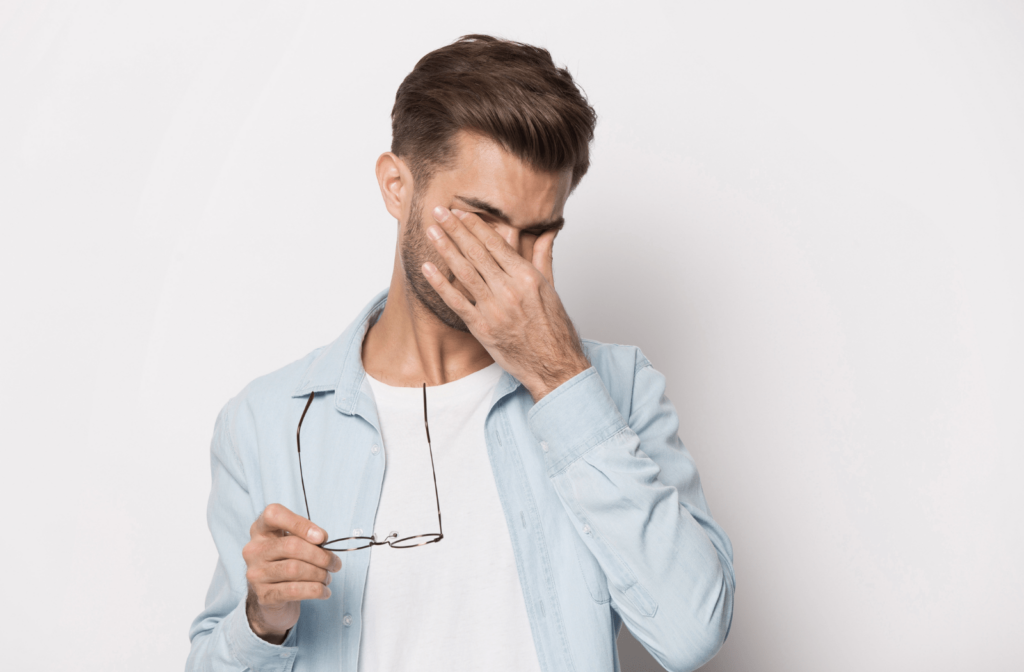Blinking is mostly an involuntary or automatic process. It’s essential to bathe the eyes in tears, providing lubrication and moisture and removing or protecting them from irritants. So when you suddenly feel pain with every blink or if your eyes feel dry no matter how much you blink, you may have dry eyes.
As a rising eye condition and millions of people suffering from it, dry eyes can lead to uncomfortable vision. But there is hope in providing relief for your dry eye symptoms.
A comprehensive eye exam conducted by your optometrist can help determine the cause of your dry eyes. Depending on the cause and the type of dry eye you may have, they can customize a treatment plan that works best for you.
Yes, there are different types of dry eyes. We look at dry eye disease and both types in more detail below.
Dry Eye Disease
Dry eye disease results from a lack of tears or the production of poor-quality tears. Tears consist of three layers:
- Lipid or oil layer: Forms the outside layer of the tear film. It prevents the tears from drying out too quickly and is made by the meibomian glands in the eye.
- Water layer: Forms the middle layer of the tear film and makes up the majority of tears. It comes from the lacrimal glands in the eye.
- Mucin or mucus layer: Forms the inner layer of the tear film made by the eye’s conjunctiva (clear tissue over the white part of the eye). It helps tears stick to the eyes.
Types of Dry Eye Disease
There are 2 types of dry eye. When dry eyes result from insufficient tears or the watery part of the tear film, it is called an aqueous deficient dry eye (ADDE). When dry eyes result from tears evaporating too quickly from a deficiency in the lipid layer, it is called an evaporative dry eye (EDE).
Aqueous Deficient Dry Eye
ADDE is less common as it accounts for one-tenth of dry eye disease. The cause of ADDE is a reduction in the watery component of tears from the lacrimal glands.
Causes of ADDE include:
- Some medications: Side effects of antihistamines, antidepressants, and blood pressure medication reduces tear production.
- Autoimmune disorder: Patients with Sjogren’s syndrome don’t produce tears due to nonfunctioning glands that lead to dry eyes and mouth.
- Health problems: Viruses, HIV, Sarcoidosis, Amyloidosis, Lymphoma
- Age: As you age, you produce fewer tears.
Symptoms of ADDE include:
- Redness
- Grittiness
- Burning sensations
- Tired eyes
- Itchy eyes
- Pain
- Blurry vision
- Trouble wearing contact lenses
- Not enough tears when you cry
Treatment of ADDE includes:
- Treat underlying medical conditions such as Sjogren’s syndrome or other diseases.
- Use artificial tears without preservatives to keep the eyes lubricated and moist.
- Omega-3 fatty acid supplements. Consult your doctor before taking these to ensure proper dosage.
- Eye drops help glands produce more tears.
- Drainage hole plugs to keep tears produced in the eyes longer. Plugs are temporary or permanent.
- Surgery to permanently close drainage holes is an option. Speak to your doctor if this is right for you.
Evaporative Dry Eye
EDE is more common and accounts for 85% of dry eye diseases. The cause of EDE is a deficiency in the lipid layer produced by the meibomian glands that increases tear evaporation. Meibomian gland dysfunction (MGD) is when the glands get clogged or inflamed.
Causes of EDE include:
- Blepharitis: Inflammation of the eyelid
- Less blinking causes debris to accumulate in the eyelids
- Computer usage
- Women: Wearing makeup
- Skin conditions: Rosacea and psoriasis
- Long-term contact lens wear
- Eye injury
- Aging
There can be some overlap in symptoms between aqueous deficient dry eye and evaporative dry eye. Symptoms of EDE include:
- Grittiness
- Burning sensation
- Blurred vision that comes and goes
- Crustiness
- Inability to tolerate wearing contact lenses
- Sensitivity to light
- Eye fatigue
Treatment of EDE includes:
- Warm compress: For moderate blockage, apply a warm compress to the eyelids.
- Lid scrub or exfoliation: To clean the lashes of the eyelids and get rid of oil and bacteria that may be blocking the gland opening.
- Massage: Gently massaging the eyes can release tears and keep the oil glands open.
- For severe blockage, treatment options are Lipiflow or Intense Pulsed Light.
Dry Eye Relief in Connecticut
Dry eye disease may appear complex, but regular eye exams and prompt treatment with in-office procedures and at-home strategies can provide long-lasting relief. You can say goodbye to irritating and uncomfortable dry eyes by booking an appointment with Higgins Brothers’ Vision Care and say hello to comfortable, hydrated vision.




